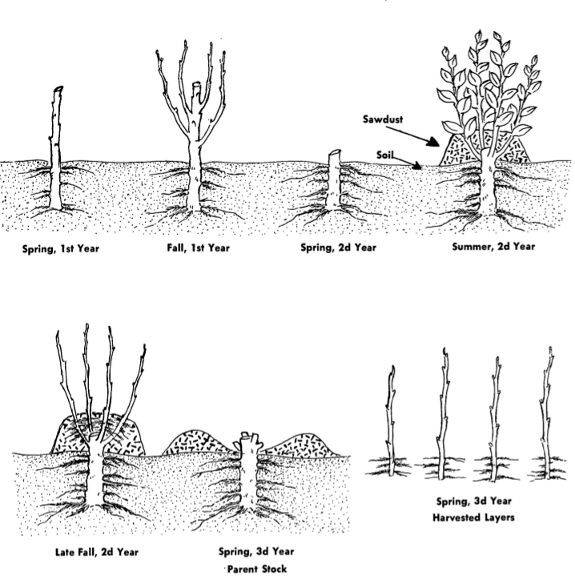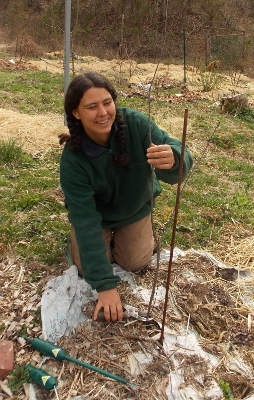
Stooling an apple rootstock

It seems a bit
counter-intuitive to go out in the spring and cut down a baby apple
tree, but that's exactly why I planted the tree below. I set out
the Budagovski 9 (aka Bud 9) rootstock last spring with the intention of
using it to create more rootstocks for grafting in spring 2015.
To that end, I let the tree grow for a year, and now I'm cutting it back
to prompt the tree to send out shoots.
 The
image above, from the 1957 Oregon Extension Service document
"Propagating Clonal Rootstocks," sums up the process of stooling very
succinctly. I'll keep my eye on my little tree this spring, and
once the shoots are four to six inches tall, I'll mound up sawdust (or
perhaps dirt) around the lower half. Just like hilling potatoes,
I'll come back through a couple of times during May and June, adding
more sawdust until my mounds are 12 to 15 inches tall.
The
image above, from the 1957 Oregon Extension Service document
"Propagating Clonal Rootstocks," sums up the process of stooling very
succinctly. I'll keep my eye on my little tree this spring, and
once the shoots are four to six inches tall, I'll mound up sawdust (or
perhaps dirt) around the lower half. Just like hilling potatoes,
I'll come back through a couple of times during May and June, adding
more sawdust until my mounds are 12 to 15 inches tall.
After that, it's a
waiting game. The tree will send out roots into the sawdust around
the base of each shoot, and by this time next year I'll be able to rake
back the sawdust, clip off the rooted shoots, and use them as
rootstocks for another dwarf tree planting.
I only expect a few shoots this first year, but the stool (plant I'm
cutting from) should increase production over time, and can keep
churning out shoots for over a decade. Not a bad return on my few
dollar investment.
Although I don't know for
sure that my stooling experiment will work out, I'm confident enough
that I'm adding three more rootstock varieties to the row this year ---
MM111 and M7 for apples, plus OHxF for pears. I know that seems a
little overboard since I just grafted a dozen new trees last month,
but I love propagating, and I've never had any of my new perennials go
to waste. If we don't use them, they make great gifts!
Want more in-depth information? Browse through our books.
Or explore more posts by date or by subject.
About us: Anna Hess and Mark Hamilton spent over a decade living self-sufficiently in the mountains of Virginia before moving north to start over from scratch in the foothills of Ohio. They've experimented with permaculture, no-till gardening, trailersteading, home-based microbusinesses and much more, writing about their adventures in both blogs and books.
Want to be notified when new comments are posted on this page? Click on the RSS button after you add a comment to subscribe to the comment feed, or simply check the box beside "email replies to me" while writing your comment.

Bud 9 happens to make decent eating apples. Tinged with red inside.
Have you thought about just rooting cuttings? Rootstocks are of course chosen for rooting abilities, etc. If you root cuttings you preserve your rootstock tree and you can make more of your roots and at a faster pace. You know, 1 sucker, against a branch that can be cut to multiple pieces.
Its what I do. I have an m111 tree and several bud 9's(I like their fruit), and I just take cuttings and root them. Sometimes I'll even do grafts on the trees, then just air layer the branches then plant them out.
Josh --- The Reference Manual of Woody Plant Propagation says: "Apple rootstocks...have been propagated from hardwood material. This technique is most logically accomplished in regions with mild winter temperatures. Hardwood cuttings of apple are harvested in fall or late winter, the basal ends are treated with root-promoting cemicals (IBA 2500 to 5000 ppm). After hormone treatment the cuttings are bundled together and placed in damp packing material (peat moss and sand) contained in insulated bins with bottom heat (64 to 70 F) for about 4 weeks. The tops are left exposed to the cool temperatures. Cuttings are transplanted before bud growth commences which is about the time roots begin to emerge."
I wouldn't try this with eating apple varieties, though, just with rootstocks since the latter have been selected for ease of rooting. Unfortunately, I can't answer your question about organicness of rooting hormone, but from a personal perspective, I wouldn't worry about it since you won't be eating anything from that tree until years later, at which point any impact of the rooting hormone will be long gone.